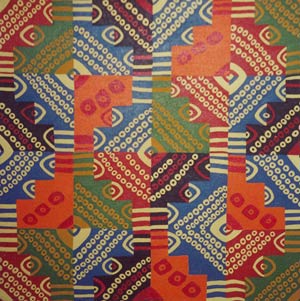| Visual Arts | U.S.A. | ||||||||||||||||||||||||||||||||||||||||||||||
BAFA © 2010. All material here is copyrighted. See conditions above. |
Beth Yazhari, painting, textiles, U.S.A.
|

Beth, Ramine and Mark Yazhari |
Born in Indianapolis in 1973, I loved drawing and painting from a very early age. Although I pursued the idea of writing professionally for a while, and received my bachelor's degree in English literature from Northwestern
University in 1995, I fell in love with painting again while studying there, as a result of taking some classes in the painting department. So I then attended the School of the Art Institute of Chicago, graduating with a Bachelor of Fine Arts in 1998. I began in painting, but was quickly attracted to the smaller, more welcoming Fiber Department, with its emphasis on women's issues and its embrace of pattern, decoration and narrative. |
Classes such as "Frank Lloyd Wright and the Prairie School, " which included extensive discussion of William Morris and the Arts and Crafts Movement, gave me a more holistic view of art and how it affects our environment, and classes in silk-screening, weaving, fabric painting and textile design instilled in me a deep love for color theory, designing from nature, and drawing on the rich textile traditions from cultures around the world as inspiration for my work.
Peru, one of the nine works in World Quilt One. It consists of nine, eighteen-inch square panels, each painted with a pattern adapted from a textile design from a different culture. I researched textiles from all around the world before choosing nine of my favorites that both worked together formally and expressed the widest geographical diversity possible, given the limitation of the piece's size. The top row features a Texas quilt, a felted piece made by nomads in Uzbekistan, and an ancient Peruvian mantle. The middle row features a marriage canopy from India, an African weaving, and an English floral design from the 19th century Arts and Crafts movement. The bottom row features an ancient Coptic Christian textile
from Egypt meant to ward off the evil eye, a design from a royal Japanese kimono, and an embroidered cushion from Turkey.
|

Every Planet Has Its Creatures, 1998,
33 x 33 inches. The abstract composition is hand-painted on cotton with a grid of paisleys embroidered over it. The paisley designs, adapted from an Indian Kashmir shawl, were added a year after the painting. "Every Planet Has Its Creatures," made for my senior art show in 1998, began as an abstract painting done with dyes on fabric, which was later transformed by the addition of a hand-embroidered grid of paisleys. I thought a lot about the creative process during this piece, as it was very labor-intensive, and I think about its two phases as being illustrative of a sort of Creation myth. The initial phase, painting the colorful background, is like a big bang of sheer creative joy, while the second phase, embroidering the grid of paisleys, symbolizes God methodically filling this creation with life. The paisley I chose is a design adapted from one on an Indian Kashmir shawl, and it is an organic, amoeba-like shape suggestive of movement. However, my paisley "creatures" are not entirely free to move about as they will, for there is an underlying pattern to their universe, which is controlled by their creator. Ye are all the leaves of one tree - image to come - by Beth Yazhari. |
 Celestial Bridge by Beth Yazhari. |
"Celestial Bridge," completed in 2001, is one of my first experiments with incorporating fabrics into my paintings. The "bridge" that cuts horizontally across the work is a piece of commercial fabric, the colors of which I echoed
in the vertical stripes of paint below it. The two orbs are also cut from commercial "quilters'" fabrics. After completing this painting and a few others that also utilized textiles, I discovered the work of Miriam Schapiro and the other painters of the Pattern and Decoration Movement. I admire Schapiro's "femmages," which are large-scale
feminist-oriented collages of paint and fabric, and like her, I am interested in calling into question the distinction between "high art" and the art women unassumingly make without thinking of themselves as artists.
|
Currently, I am working on a series of paintings composed of fabrics passed down to me from my grandmother, who always believed that she didn't have an artistic bone in her body, despite the fact that she delighted in kitschy decorations for her home and was a prolific seamstress. In an homage to her, a hard-working mother of five in the 60s, I am creating designs on canvases from elements and motifs from her fabrics. These paintings reference kaleidoscope images,
Amish quilts, and Oriental rugs, and the first, "Tribute to Elva Fern," is almost complete. It will be a companion piece to a fabric wall-hanging I did in 2001, incorporating large beads from many of my grandmother's vintage necklaces with pieces of fabric and embroidery. |
|
Arts Dialogue, Dintel 20, NL 7333 MC, Apeldoorn, The Netherlands email: bafa@bahai-library.com |
